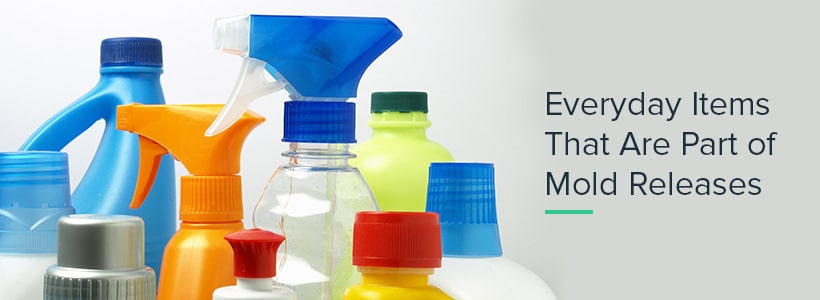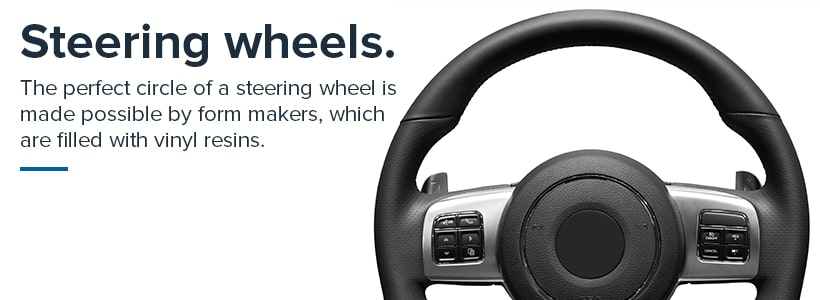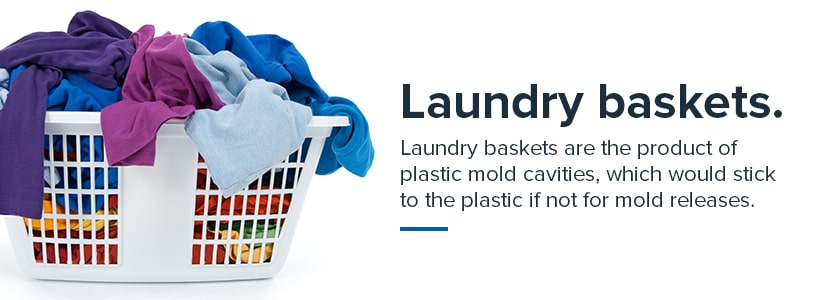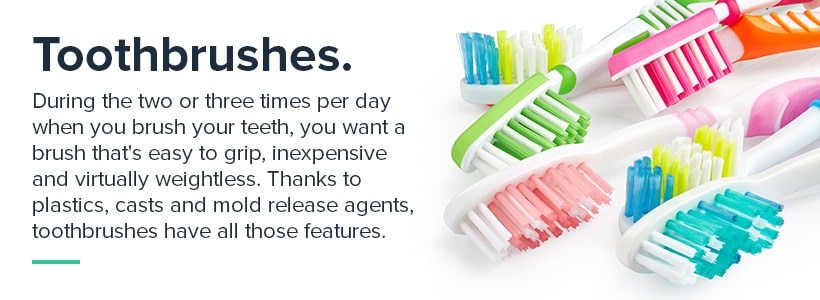Everyday Items That Are Part of Mold Releases
Modern-day households are full of products that seem simple enough, but those products are actually brought into existence through a complex set of production methods. For example, all items made of hard, synthetic materials generally result from the following process:
- Hot, liquid synthetics are poured into mold cavities.
- The synthetic dries and hardens inside a cavity.
- The cavity is pulled, peeled or broken away to reveal the plastic shape.
With everything from mold plastics to rubber release agents for bladder coatings, the process could be compared to baking. Just as muffins, rolls and biscuits could easily bond to a pan without the use of butter or nonstick spray, mold release agents make it possible to pour plastic into cavities without the two becoming stuck to one another.
Packaging
A lot of the products you see in supermarkets are sold in containers that are made with mold releases. Containers in this category would include just about anything that stores juices or yogurt, as well as soaps, detergent and makeup. Basically, if it’s not packaged in paper or cardboard, the container probably needed a mold release formula to separate from its mold cavity. Here are some examples:
Plastic bottles. The plastic bottles you see in grocery stores for fruit drinks and soda pop are produced in factories that use mold forms. However, the plastics would never come free from the shape makers without the use of mold releases. The same is true for the bottle caps, whether they’re white, blue, orange or some other color.
Food containers. Any plastic container or tray that bears a specific shape has been through a formation process that involves mold release agents. This is true for both the round containers that store yogurt and sour cream, as well as the trays used in TV dinners.
Cosmetic containers. Makeup products are sold in plastic containers made with mold releases. From lipstick dispensers and eye shadow mirror/tray combos, to mascara containers and the bottle caps on concealer bottles, there’s hardly an exception to the rule.
Soap dispensers. Liquid soap dispensers are a marvel in mold formation, where different shaping patterns are used to mold the plastic of the container as well as the tube/lever combo — making the household dispenser such a convenient device in kitchens and bathrooms.
Detergent containers. Laundry products are all made with mold releases, which are necessary to remove forming materials from the newly made containers. Thanks to their construction process, detergent containers are extra efficient — the inside of the handle itself is hollow and can, therefore, store extra ounces of detergent or fabric softener.
Medicine bottles. While the typical medicine container has a relatively simple design, the lids are another marvel of plastic molding due to the locking mechanisms, which make them tricky to open and, therefore, mostly childproof.
Plastic storage container. The clear containers that are sold in packages of three, four or six are made when liquid plastic is poured into a molding cavity. Once the plastic is dry and hard, the cavity pieces are removed, but this is only possible with mold releases. Otherwise, the plastic would bond to the shape makers.
If it weren’t for plastics, a lot of your food and hygiene products would have to be sold in glass or wood containers. We wouldn’t have the the efficient, compact plastic containers today, however, without mold release agents.
Sporting Goods
At sporting shops throughout the U.S., roughly half the products are produced in form-makers that are pulled or peeled away to reveal shapes of perfect roundness and circumference, or dimension and angularity. Unless the item is sewn or carved, chances are it was produced with the use of mold releases:
Golf balls. The shape of a golf ball is made possible by the circular molding technology and formulas that are part of the mold-release method of production. Everything from the roundness of the ball to the spin skins and dimples that make it fly far are products of this method.
Bicycle parts. Most of the components of a typical bicycle are formed inside mold castings that are pulled and peeled away once the shapes are hardened. The peeling is made possible by release formulas, and the process is responsible for the top tube, front tube, down tube, chain ring and various other parts.
Hockey sticks. The mightiest instrument used on ice is arguably the hockey stick, which originates from parts molded by metal and synthetic properties. Unless the stick is largely made of wood, chances are the toe, heel, shaft and butt end are products of the mold-release process.
Rollerblade wheels. There’s perhaps no other sporting footwear that offers as much speed and freedom as rollerblades. However, the wheels that send your legs rolling fast would be difficult, if not impossible, to produce with such circular perfection without the uniform, reliable molding technology that only works with release formulas.
Racquet frames. When you think of racquets, the first thing that comes to mind is probably the grid between the loop. However, the gridding would never hold together without a solid frame, which is produced at factories with molding forms and release agents.
Ski boot inserts. For proper balance and comfort on the snowy mountain slopes, insoles are a crucial part of skiing footwear. For skiers of all heights, weights and ages, ski boot inserts are formed inside shape-makers that are peeled away with mold releases.
Fishing rods. Fishing is a favorite pastime of many people. Being able to catch fish wouldn’t be possible, however, without optimal fishing equipment. It has improved with the ages, too, thanks to mold makers and release formulas.
Kayaks. In the early days of human existence, floatable devices consisted of wood. Today, synthetic materials like rotomolded polyethylene have made it possible to mass-produce kayaks in an assortment of colors. Nonetheless, the process of modern kayak-making is the result of mold-release formulas and tools.
Today’s sporting-goods supplies are more efficient than ever, thanks to the advanced tools and solutions available at contemporary factories. Whenever you see a great set of rollerblades or a bright and shiny kayak, thank modern technology and the unique power of mold releases.
Automobiles
Across the exterior, interior and circuitry of any car or truck, hundreds of parts are pieced together, most of which originate from a process that involves shape makers, steels or synthetics and mold release agents. In fact, just about everything you see, operate and fix on a given vehicle are the result of this process:
Seating. Many of the parts that comprise the typical car seat are products of mold release formulas and form makers. Examples include the tracks, seat belt, adjustment handles and base. Basically, any part that hasn’t been constructed with industrial sewing machinery has used mold release formulas in their production.
Steering wheels. The perfect circle of a steering wheel is made possible by form makers, which are filled with vinyl resins. Additionally, the hub, nuts, bearings, buttons, lever, horn contact and other components of the steering wheel are also products of the mold release process.
Dashboards. The pieces that make up a typical dashboard are molded from synthetics in shape makers at auto parts factories. This includes the counter itself, as well as the glove compartment, monitor screen and various control buttons for the lights, vents and heating system.
Engine parts. Automotive engine parts are made in mold release plants, where steels and synthetics are poured into form makers and released once hardened. Examples include everything from the oil and coolant gaskets to the crank shaft, alternator, valves and spark plugs.
Chassis. The underlying chassis of a given vehicle consists of various parts that originate from mold release productions. This includes all the parts that keep the car stable and balanced, such as the rear spring, coil spring, shackle, spring hanger and upper-control arm, not to mention the tail pipes.
Tires. Nothing is more responsible for the motion of an automobile than the tires, the roundness of which is made possible by the mold release process. At tire plants, rubbers are poured into shaping molds with distinct circumferences for particular car models. The tire grooves that give you traction on the road are the result of this shaping process.
Hubcaps. The pieces that keep your tires secured to the axles are produced with mold release formulas and methods. The roundness and perfect fit of each hubcap piece — the spinner, the valve stern cap, the front wheel dust cap — result from this process.
Body parts. The parts that comprise the shell of a car or truck are done with mold release agents and form makers at auto-parts plants. Everything from the doors, roof and hood to the trunk, latches and handles take shape during this stage of the auto–making process.
No matter what type of vehicle you drive, it’s unlikely that most of the parts could be produced without mold release formulas. In mass productions of cars and trucks, the method is responsible for the aligning measurements and perfect shape of each component.
Household Items
There are various items in your living room, bathrooms, bedroom and laundry room that originate from a process where plastics are poured into mold cavities and, once hardened, freed with the anti-adhesive qualities of release agents. Any of the following products in your house have likely involved this method:
Laundry baskets. Whether they’re round or rectangular, or they consist of small or wide grids, laundry baskets are the product of plastic mold cavities, which would stick to the plastic if not for mold releases.
Shelf bins. In work rooms, plastic is a convenient shelving material due to its light weight. At home-supply stores, you’re likely to find a variety of plastic shelves and drawers that can be custom-stacked to various heights. The shape of each component, however, is the work of mold cavities and release agents.
Pens. Whether you’re at a desk or out shopping, a pen is one item you should always have on hand. Though you might not give it much thought, pens consist of tubular and cone-shaped moldings that could never be made without release agents.
Telephones. While the technology for telecommunication has changed over the past few decades, mold cavities and release agents remain invaluable to the production of any type of phone, be it an old-fashioned cord phone or a wireless smartphone.
Fans. Once upon a time, humid temperatures and stuffy environments were hard things to endure. Then came the fan, which has always been the product of mold release agents and cavities, regardless of whether the blades, screen and enclosure are made of synthetics or metal.
Light switch cases. In rooms and hallways, switches make light easily accessible with a single flick. However, it’s the molded plastic encasement that makes such switches safe. Otherwise, light switches — as well as electrical outlets — would be holes in walls with exposed, dangerous circuitry.
Outlet extensions. Outlet circuitry can be dangerous as well, which is why it must be encased. In modern homes where up to a dozen outlets per room are necessary, outlet extensions save the day with circuitry housed in molded, plastic enclosures.
Toothbrushes. During the two or three times per day when you brush your teeth, you want a brush that’s easy to grip, inexpensive and virtually weightless. Thanks to plastics, casts and mold release agents, toothbrushes have all those features.
Combs. A typical comb might seem like the simplest of all grooming devices, but the teeth on your comb would be hard to produce — and probably end up costing a whole lot more — if not for the streamlined production capabilities afforded by plastics, mold cavities and release agents.
Handheld dusters. Dust can form in the most inconvenient places, and you need something to eliminate it in those hard-to-reach places. That’s where the plastic handle of a duster comes in handy. It may be solid or retractable, but it’s one of the essential household products to originate from synthetics, mold cavities and release agents.
Vacuum components. After the vacuum sucks up all the dirt and grime from your rugs and carpeting, it stores it in the canister or in a bag in the canister. This would hardly be possible, though, without the hoses and encasements, which are produced in synthetic molding factories.
Some of these products have changed drastically over the past 50 years to reflect evolutions in style and taste. Still, the means by which such products are made has mostly remained the same since the development of synthetics, mold cavities and release agents.
Kitchen Appliances and Cooking Utensils
In your kitchen, it’s not just the things you bring home from the supermarket that are made with mold cavities and release agents. In all likelihood, you have at least two of the following items, each of which are made from hot synthetics that are poured into cavity molds, but wouldn’t ever emerge from the molding stage without the use of release agents:
Blenders. Perhaps the most complex kitchen appliance to rely on mold release methods is the blender, which consists of buttons, a lid, an enclosure and a big, clear blender jar complete with measurements. Each of these pieces and details would not be possible without mold release technology.
Ice cube trays. The ability to shape water into ice cubes is a perfect example of turning liquids into solids. Funny enough, the tray undergoes a molding process itself, where release agents are used to pull the slot-makers out.
Spatulas. Of all the cooking utensils, spatulas are most essential when it comes to preventing dough and batter from bonding to mixing bowls. Ironically, spatulas rely on mold release agents for a similar reason: to avoid getting stuck inside mold cavities when the plastic is hot.
Plastic utensils. Pretty much any utensil in your kitchen that doesn’t consist of wood will have likely involved mold release agents during its production.
Coffee brewers. While brewers have existed in a variety of forms for many decades, today’s brewers consist of synthetic parts — typically either black or white — that are made in mold castings.
Manufactures continue to innovate in the area of kitchen appliances, but one thing is likely to still be in use for decades to come, regardless of the materials used: mold release agents.
Computers and Peripherals
In most of today’s households, computer setups are as common as big, wooden television sets and antennas were in the old days. Interestingly, the computer table might boast the single biggest collection of individual parts in a given house that are made of synthetics, mold cavities and release agents, such as the following:
Monitor cases. Even though computer monitors have gotten thinner and more lightweight over the past decade, their composition remains the same: complex circuitry encased with synthetic materials, which are formed in mold cavities with the help of release agents.
Thumb drives. The ability to store gigabytes of data onto thumb-sized USB drives would probably not be possible if computer peripheral manufacturers lacked the ability to mold synthetic handles, which protect the sensitive data on such drives.
Speakers. Today, computer speakers are a household must as computers usurp televisions and stereos in many households. Interestingly, each shape you see in the design of your speakers is made with the use of mold release agents.
Scanners. Scanners of today are highly efficient. You can simply scan a photo or a document, and it immediately shows up as a file on your computer — but it’s hard to imagine how cumbersome and heavy your scanner might be if manufacturers lacked the ability to make synthetic enclosures with mold cavities.
Printers. One of the most complex of peripherals is the printer because it consists of various parts that either feed paper or ink. From the enclosure and trays to the assorted printing cartridges, each component is made from mold cavities and release agents.
External hard drives. If your collection of digital files is well into terabytes, it’s wise to have them stored locally on a separate device from your computer. That said, no external hard drive would be nearly as sleek and secure without its plastic casing — the product of today’s mold release technology.
Keyboards. Every button on your keyboard is the product of mold castings done with release agents. Unless, of course, you have a membrane keyboard, but even that would consist of a top and bottom that originates from mold cavities.
Mice. While the mouse is small and simple, it consists of a handful of parts — the top, the bottom and the roller ball — that are mass produced with mold castings and release agents.
Computers get smaller while monitors get larger, but whether the future emphasizes all-in-one computers or handheld wireless tablets, the components that connect you to the internet will continue to consist of parts made from plastics, cavities, and release agents.
With more than 20 years in the mold release industry, W.N. Shaw provides services for a range of applications across the industrial sector. From the worlds of aerospace and construction to automobile manufacturing, we are a customer formulator that makes silicone and water-based mold release agents. To learn more about our services, contact us today.










